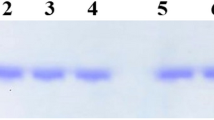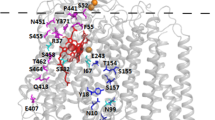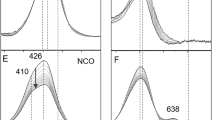Abstract
THE presence of modified cytochrome c in the widely used Keilin and Hartree preparation was first reported by Margoliash1. Separation was effected by chromatography at pH 7.0 on a column of the resin ‘Amberlite IRC-50’ Modified material was present to the extent of 10–25 per cent and was characterized by having a lowered enzymatic activity in the cytochrome oxidase (heart muscle) and succinic oxidase (kidney) systems but an increased rate of ascorbic acid oxidation. Visual spectroscopy, however, did not show any difference between this and other cytochrome c fractions. Evidence was presented that the modification was caused by the action of trichloracetic acid on cytochrome c during the extraction procedure.
This is a preview of subscription content, access via your institution
Access options
Subscribe to this journal
Receive 51 print issues and online access
$199.00 per year
only $3.90 per issue
Buy this article
- Purchase on Springer Link
- Instant access to full article PDF
Prices may be subject to local taxes which are calculated during checkout
Similar content being viewed by others
References
Margoliash, E., Biochem. J., 56, 535 (1954).
Henderson, R. W., and Rawlinson, W. A., Biochem. J., 62, 21 (1956).
Ball, E. G., Symposium on Respiratory Enzymes, 21 (Univ. Wisconsin Press, Madison, 1942).
Author information
Authors and Affiliations
Rights and permissions
About this article
Cite this article
HENDERSON, R., RAWLINSON, W. Oxidation-Reduction Potential of Modified Cytochrome c . Nature 177, 1180–1181 (1956). https://doi.org/10.1038/1771180b0
Issue Date:
DOI: https://doi.org/10.1038/1771180b0
Comments
By submitting a comment you agree to abide by our Terms and Community Guidelines. If you find something abusive or that does not comply with our terms or guidelines please flag it as inappropriate.



